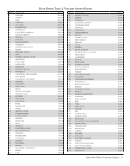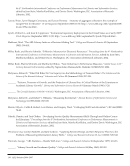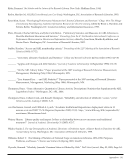92 · ARL Statistics 2006–2007
Include duplicates and bound volumes of periodicals. For purposes of this questionnaire, unclassified bound serials
arranged in alphabetical order are considered classified. Exclude microforms, maps, nonprint materials, and uncataloged
items. If any of these items cannot be excluded, please provide an explanatory footnote
Include government document volumes that are accessible through the library’s catalogs regardless of whether they are
separately shelved. “Classified” includes documents arranged by Superintendent of Documents, CODOC, or similar
numbers. “Cataloged” includes documents for which records are provided by the library or downloaded from other
sources into the library’s card or online catalogs. Documents should, to the extent possible, be counted as they would
if they were in bound volumes (e.g., 12 issues of an annual serial would be one or two volumes). Title and piece
counts should not be considered the same as volume counts. If a volume count has not been kept, it may be estimated
through sampling a representative group of title records and determining the corresponding number of volumes, then
extrapolating to the rest of the collection. As an alternative, an estimate may be made using the following formulae:
52 documents pieces per foot
10 “traditional” volumes per foot
5.2 documents pieces per volume
Include e-book units, as long as these e-books are owned or leased and have been cataloged by your library. Include
electronic books purchased through vendors such as NetLibrary® or Books 24x7, and e-books that come as part of
aggregate services. Include individual titles of e-book sets that are treated as individual reference sources. Include
locally digitized electronic books and electronic theses and dissertations. Provide a footnote explaining how many
e-books you are reporting, preferably by specifying the products and the number of titles in a note.
Include volumes purchased collectively where the cost is shared at the time of purchase.
If either formulas or sampling are used for deriving your count, please indicate in a footnote.
Question 1b. Volumes Added. Include only volumes cataloged, classified, and made ready for use. Include government
documents if they have been included in the count of volumes on line 1a. Do not include as part of Volumes Added
Gross any government documents or other collections (such as large gift collections or e-book packages) that were
added to the collection as the result of a one time download or addition to the OPAC. Include these items in Volumes
Held of the previous year (Line 1a) and provide a footnote explaining the revision of Line 1a.
Question 2. Monographic Volumes Purchased. Report number of volumes purchased do not include volumes received
or cataloged. Include all volumes for which an expenditure was made during 2006-07, including volumes paid for in
advance but not received during the fiscal year. Include monographs in series and continuations. Include e-books that
fit the NetLibrary® model, i.e., electronic manifestations of physical entities and/or units provide a footnote explaining
how many e-books you are reporting, preferably by specifying the products and the number of titles. If only number of
titles purchased can be reported, please report the data and provide an explanatory footnote.
Question 3: Basis of Volume Count. A physical count is a piece count a bibliographic count is a catalog record count.
Questions 4-5. Serials. Use the following definition for a serial:
a publication in any medium issued in successive parts bearing numerical or chronological
designations and intended to be continued indefinitely. This definition includes periodicals,
newspapers, and annuals (reports, yearbooks, etc.) the journals, memoirs, proceedings,
transactions, etc. of societies and numbered monographic series.
Include duplicates and bound volumes of periodicals. For purposes of this questionnaire, unclassified bound serials
arranged in alphabetical order are considered classified. Exclude microforms, maps, nonprint materials, and uncataloged
items. If any of these items cannot be excluded, please provide an explanatory footnote
Include government document volumes that are accessible through the library’s catalogs regardless of whether they are
separately shelved. “Classified” includes documents arranged by Superintendent of Documents, CODOC, or similar
numbers. “Cataloged” includes documents for which records are provided by the library or downloaded from other
sources into the library’s card or online catalogs. Documents should, to the extent possible, be counted as they would
if they were in bound volumes (e.g., 12 issues of an annual serial would be one or two volumes). Title and piece
counts should not be considered the same as volume counts. If a volume count has not been kept, it may be estimated
through sampling a representative group of title records and determining the corresponding number of volumes, then
extrapolating to the rest of the collection. As an alternative, an estimate may be made using the following formulae:
52 documents pieces per foot
10 “traditional” volumes per foot
5.2 documents pieces per volume
Include e-book units, as long as these e-books are owned or leased and have been cataloged by your library. Include
electronic books purchased through vendors such as NetLibrary® or Books 24x7, and e-books that come as part of
aggregate services. Include individual titles of e-book sets that are treated as individual reference sources. Include
locally digitized electronic books and electronic theses and dissertations. Provide a footnote explaining how many
e-books you are reporting, preferably by specifying the products and the number of titles in a note.
Include volumes purchased collectively where the cost is shared at the time of purchase.
If either formulas or sampling are used for deriving your count, please indicate in a footnote.
Question 1b. Volumes Added. Include only volumes cataloged, classified, and made ready for use. Include government
documents if they have been included in the count of volumes on line 1a. Do not include as part of Volumes Added
Gross any government documents or other collections (such as large gift collections or e-book packages) that were
added to the collection as the result of a one time download or addition to the OPAC. Include these items in Volumes
Held of the previous year (Line 1a) and provide a footnote explaining the revision of Line 1a.
Question 2. Monographic Volumes Purchased. Report number of volumes purchased do not include volumes received
or cataloged. Include all volumes for which an expenditure was made during 2006-07, including volumes paid for in
advance but not received during the fiscal year. Include monographs in series and continuations. Include e-books that
fit the NetLibrary® model, i.e., electronic manifestations of physical entities and/or units provide a footnote explaining
how many e-books you are reporting, preferably by specifying the products and the number of titles. If only number of
titles purchased can be reported, please report the data and provide an explanatory footnote.
Question 3: Basis of Volume Count. A physical count is a piece count a bibliographic count is a catalog record count.
Questions 4-5. Serials. Use the following definition for a serial:
a publication in any medium issued in successive parts bearing numerical or chronological
designations and intended to be continued indefinitely. This definition includes periodicals,
newspapers, and annuals (reports, yearbooks, etc.) the journals, memoirs, proceedings,
transactions, etc. of societies and numbered monographic series.














































































































































